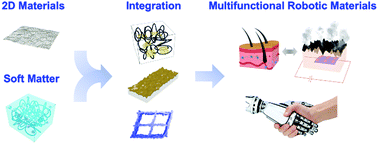当前位置:
X-MOL 学术
›
Mater. Horiz.
›
论文详情
Our official English website, www.x-mol.net, welcomes your feedback! (Note: you will need to create a separate account there.)
Recent advances in integration of 2D materials with soft matter for multifunctional robotic materials
Materials Horizons ( IF 13.3 ) Pub Date : 2019-09-10 , DOI: 10.1039/c9mh01139k Lin Jing 1, 2, 3, 4 , Kerui Li 1, 2, 3, 4 , Haitao Yang 1, 2, 3, 4 , Po-Yen Chen 1, 1, 2, 3, 4
Materials Horizons ( IF 13.3 ) Pub Date : 2019-09-10 , DOI: 10.1039/c9mh01139k Lin Jing 1, 2, 3, 4 , Kerui Li 1, 2, 3, 4 , Haitao Yang 1, 2, 3, 4 , Po-Yen Chen 1, 1, 2, 3, 4
Affiliation

|
Emerging soft robots with infinite degrees of freedom are one step closer to providing better human–machine interactions than conventional hard and stiff robots, attributing to their outstanding compliance/adaptability, evenly distributed stress, and programmable actuating behaviors. Soft matter (e.g., hydrogels and elastomers) with high mechanical stability has been usually adopted for the fabrication of soft robots. However, soft matter exhibits limited optical, electrical, thermal, and chemical properties that restrict the development of functional soft robots. An emerging approach is to develop multifunctional robotic materials that are reconfigurable and can provide diverse built-in functions, such as wide-spectrum protection, tactile sensing, remote control, and wireless communication. To realize this approach, two-dimensional (2D) materials with diverse yet unique physicochemical properties have been recently integrated with soft matter to bring in add-on functionalities for fabricated soft robots. In this Minireview, we highlight three integration approaches for the fabrication of 2D material–soft matter robotic materials: (i) heterogenous blending of 2D materials within soft matter precursors followed by in situ crosslinking/curing; (ii) bilayer integration of 2D materials with soft matter substrates; and (iii) post-stabilization of 2D material (or 2D material-templated) architectures with elastomers. The advantages and drawbacks of each approach regarding the fabrication process and resulting characteristics are discussed in detail. The reversible actuating behaviors and built-in capabilities of the as-fabricated 2D material–soft matter composites, as well as their further applications as multifunctional robotic materials are summarized. Finally, current research gaps and future directions regarding the development of multifunctional robotic materials are addressed from our perspective by considering the design principles for future untethered soft robots.
中文翻译:

二维材料与软质材料在多功能机器人材料中集成的最新进展
新兴的具有无限自由度的软机器人比传统的硬机器人和硬机器人更能提供更好的人机交互性,这要归功于其出色的顺应性/适应性,均匀分布的应力以及可编程的驱动行为。软物质(例如,水凝胶和弹性体)具有较高的机械稳定性,通常已被用于制造软机器人。但是,软物质显示出有限的光学,电,热和化学特性,从而限制了功能性软机器人的发展。一种新兴的方法是开发可重新配置的多功能机器人材料,这些材料可提供多种内置功能,例如广谱保护,触觉感应,远程控制和无线通信。为了实现这种方法,最近已将具有多样但独特的物理化学特性的二维(2D)材料与软物质集成在一起,从而为制造的软机器人带来了附加功能。在此Minireview中,我们重点介绍了用于制造2D材料(软物质机器人材料)的三种集成方法:原位交联/固化;(ii)2D材料与软质基底的双层集成;(iii)使用弹性体对2D材料(或2D材料模板)结构进行后稳定化处理。详细讨论了每种方法在制造过程和所得特性方面的优缺点。总结了所制造的二维材料-软质复合材料的可逆致动特性和内置功能,以及它们在多功能机器人材料中的进一步应用。最后,通过考虑未来不受束缚的软机器人的设计原则,从我们的角度解决了当前有关多功能机器人材料开发的研究差距和未来方向。
更新日期:2020-01-04
中文翻译:

二维材料与软质材料在多功能机器人材料中集成的最新进展
新兴的具有无限自由度的软机器人比传统的硬机器人和硬机器人更能提供更好的人机交互性,这要归功于其出色的顺应性/适应性,均匀分布的应力以及可编程的驱动行为。软物质(例如,水凝胶和弹性体)具有较高的机械稳定性,通常已被用于制造软机器人。但是,软物质显示出有限的光学,电,热和化学特性,从而限制了功能性软机器人的发展。一种新兴的方法是开发可重新配置的多功能机器人材料,这些材料可提供多种内置功能,例如广谱保护,触觉感应,远程控制和无线通信。为了实现这种方法,最近已将具有多样但独特的物理化学特性的二维(2D)材料与软物质集成在一起,从而为制造的软机器人带来了附加功能。在此Minireview中,我们重点介绍了用于制造2D材料(软物质机器人材料)的三种集成方法:原位交联/固化;(ii)2D材料与软质基底的双层集成;(iii)使用弹性体对2D材料(或2D材料模板)结构进行后稳定化处理。详细讨论了每种方法在制造过程和所得特性方面的优缺点。总结了所制造的二维材料-软质复合材料的可逆致动特性和内置功能,以及它们在多功能机器人材料中的进一步应用。最后,通过考虑未来不受束缚的软机器人的设计原则,从我们的角度解决了当前有关多功能机器人材料开发的研究差距和未来方向。



























 京公网安备 11010802027423号
京公网安备 11010802027423号